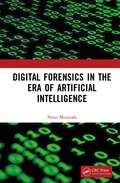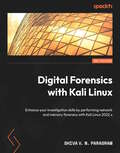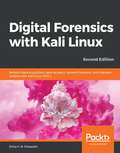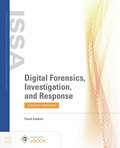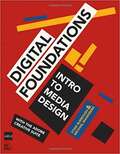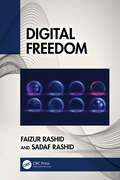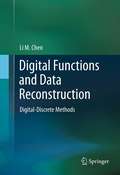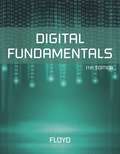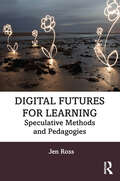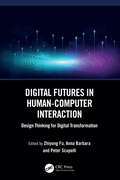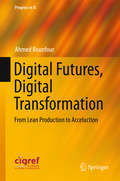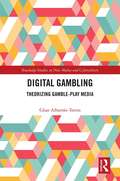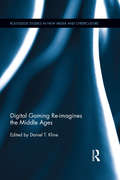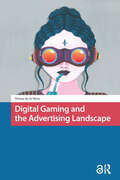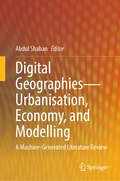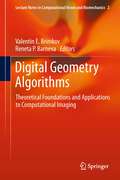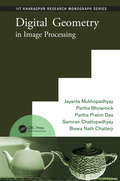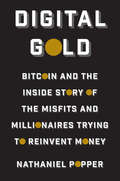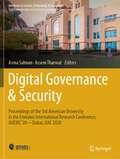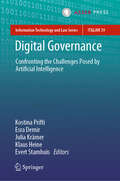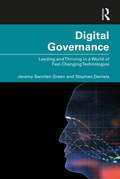- Table View
- List View
Digital Forensics in the Era of Artificial Intelligence
by Nour MoustafaDigital forensics plays a crucial role in identifying, analysing, and presenting cyber threats as evidence in a court of law. Artificial intelligence, particularly machine learning and deep learning, enables automation of the digital investigation process. This book provides an in-depth look at the fundamental and advanced methods in digital forensics. It also discusses how machine learning and deep learning algorithms can be used to detect and investigate cybercrimes. This book demonstrates digital forensics and cyber-investigating techniques with real-world applications. It examines hard disk analytics and style architectures, including Master Boot Record and GUID Partition Table as part of the investigative process. It also covers cyberattack analysis in Windows, Linux, and network systems using virtual machines in real-world scenarios. Digital Forensics in the Era of Artificial Intelligence will be helpful for those interested in digital forensics and using machine learning techniques in the investigation of cyberattacks and the detection of evidence in cybercrimes.
Digital Forensics with Kali Linux: Enhance your investigation skills by performing network and memory forensics with Kali Linux 2022.x, 3rd Edition
by Shiva V. ParasramExplore various digital forensics methodologies and frameworks and manage your cyber incidents effectivelyPurchase of the print or Kindle book includes a free PDF eBookKey FeaturesGain red, blue, and purple team tool insights and understand their link with digital forensicsPerform DFIR investigation and get familiarized with Autopsy 4Explore network discovery and forensics tools such as Nmap, Wireshark, Xplico, and ShodanBook DescriptionKali Linux is a Linux-based distribution that's widely used for penetration testing and digital forensics. This third edition is updated with real-world examples and detailed labs to help you take your investigation skills to the next level using powerful tools.This new edition will help you explore modern techniques for analysis, extraction, and reporting using advanced tools such as FTK Imager, Hex Editor, and Axiom. You'll cover the basics and advanced areas of digital forensics within the world of modern forensics while delving into the domain of operating systems. As you advance through the chapters, you'll explore various formats for file storage, including secret hiding places unseen by the end user or even the operating system. You'll also discover how to install Windows Emulator, Autopsy 4 in Kali, and how to use Nmap and NetDiscover to find device types and hosts on a network, along with creating forensic images of data and maintaining integrity using hashing tools. Finally, you'll cover advanced topics such as autopsies and acquiring investigation data from networks, memory, and operating systems.By the end of this digital forensics book, you'll have gained hands-on experience in implementing all the pillars of digital forensics: acquisition, extraction, analysis, and presentation – all using Kali Linux's cutting-edge tools.What you will learnInstall Kali Linux on Raspberry Pi 4 and various other platformsRun Windows applications in Kali Linux using Windows Emulator as WineRecognize the importance of RAM, file systems, data, and cache in DFIRPerform file recovery, data carving, and extraction using Magic RescueGet to grips with the latest Volatility 3 framework and analyze the memory dumpExplore the various ransomware types and discover artifacts for DFIR investigationPerform full DFIR automated analysis with Autopsy 4Become familiar with network forensic analysis tools (NFATs)Who this book is forThis book is for students, forensic analysts, digital forensics investigators and incident responders, security analysts and administrators, penetration testers, or anyone interested in enhancing their forensics abilities using the latest version of Kali Linux along with powerful automated analysis tools. Basic knowledge of operating systems, computer components, and installation processes will help you gain a better understanding of the concepts covered.
Digital Forensics with Kali Linux: Perform data acquisition, data recovery, network forensics, and malware analysis with Kali Linux, 2nd Edition
by Shiva V. ParasramTake your forensic abilities and investigation skills to the next level using powerful tools that cater to all aspects of digital forensic investigations, right from hashing to reporting Key Features Perform evidence acquisition, preservation, and analysis using a variety of Kali Linux tools Use PcapXray to perform timeline analysis of malware and network activity Implement the concept of cryptographic hashing and imaging using Kali Linux Book Description Kali Linux is a Linux-based distribution that's widely used for penetration testing and digital forensics. It has a wide range of tools to help for digital forensics investigations and incident response mechanisms. This updated second edition of Digital Forensics with Kali Linux covers the latest version of Kali Linux and The Sleuth Kit. You'll get to grips with modern techniques for analysis, extraction, and reporting using advanced tools such as FTK Imager, hex editor, and Axiom. Updated to cover digital forensics basics and advancements in the world of modern forensics, this book will also delve into the domain of operating systems. Progressing through the chapters, you'll explore various formats for file storage, including secret hiding places unseen by the end user or even the operating system. The book will also show you how to create forensic images of data and maintain integrity using hashing tools. Finally, you'll cover advanced topics such as autopsies and acquiring investigation data from networks, operating system memory, and quantum cryptography. By the end of this book, you'll have gained hands-on experience of implementing all the pillars of digital forensics: acquisition, extraction, analysis, and presentation, all using Kali Linux tools. What you will learn Get up and running with powerful Kali Linux tools for digital investigation and analysis Perform internet and memory forensics with Volatility and Xplico Understand filesystems, storage, and data fundamentals Become well-versed with incident response procedures and best practices Perform ransomware analysis using labs involving actual ransomware Carry out network forensics and analysis using NetworkMiner and other tools Who this book is for This Kali Linux book is for forensics and digital investigators, security analysts, or anyone interested in learning digital forensics using Kali Linux. Basic knowledge of Kali Linux will be helpful to gain a better understanding of the concepts covered.
Digital Forensics with Kali Linux: Perform data acquisition, digital investigation, and threat analysis using Kali Linux tools
by Alex Samm Dale Joseph Shiva V. N ParasramKey FeaturesMaster powerful Kali Linux tools for digital investigation and analysisPerform evidence acquisition, preservation, and analysis using various tools within Kali LinuxImplement the concept of cryptographic hashing and imaging using Kali LinuxPerform memory forensics with Volatility and internet forensics with Xplico.Discover the capabilities of professional forensic tools such as Autopsy and DFF (Digital Forensic Framework) used by law enforcement and military personnel alike Book DescriptionKali Linux is a Linux-based distribution used mainly for penetration testing and digital forensics. It has a wide range of tools to help in forensics investigations and incident response mechanisms. You will start by understanding the fundamentals of digital forensics and setting up your Kali Linux environment to perform different investigation practices. The book will delve into the realm of operating systems and the various formats for file storage, including secret hiding places unseen by the end user or even the operating system. The book will also teach you to create forensic images of data and maintain integrity using hashing tools. Next, you will also master some advanced topics such as autopsies and acquiring investigation data from the network, operating system memory, and so on. The book introduces you to powerful tools that will take your forensic abilities and investigations to a professional level, catering for all aspects of full digital forensic investigations from hashing to reporting. By the end of this book, you will have had hands-on experience in implementing all the pillars of digital forensics—acquisition, extraction, analysis, and presentation using Kali Linux tools.What you will learnGet to grips with the fundamentals of digital forensics and explore best practicesUnderstand the workings of file systems, storage, and data fundamentalsDiscover incident response procedures and best practicesUse DC3DD and Guymager for acquisition and preservation techniquesRecover deleted data with Foremost and ScalpelFind evidence of accessed programs and malicious programs using Volatility.Perform network and internet capture analysis with XplicoCarry out professional digital forensics investigations using the DFF and Autopsy automated forensic suites
Digital Forensics, Investigation, and Response
by Chuck EasttomDigital Forensics, Investigation, and Response, Fourth Edition examines the fundamentals of system forensics, addresses the tools, techniques, and methods used to perform computer forensics and investigation, and explores incident and intrusion response,
Digital Foundations: A Basic Course In Media Design (Aiga Design Press)
by Michael Mandiberg Xtine BurroughFuses design fundamentals and software training into one cohesive book ! The only book to teach Bauhaus design principles alongside basic digital tools of Adobe's Creative Suite, including the recently released Adobe CS4 Addresses the growing trend of compressing design fundamentals and design software into the same course in universities and design trade schools. Lessons are timed to be used in 50-minute class sessions. Digital Foundations uses formal exercises of the Bauhaus to teach the Adobe Creative Suite. All students of digital design and production-whether learning in a classroom or on their own-need to understand the basic principles of design in order to implement them using current software. Far too often design is left out of books that teach software. Consequently, the design software training exercise is often a lost opportunity for visual learning. Digital Foundations reinvigorates software training by integrating Bauhaus design exercises into tutorials fusing design fundamentals and core Adobe Creative Suite methodologies. The result is a cohesive learning experience. Design topics and principles include: Composition; Symmetry and Asymmetry; Gestalt; Appropriation; The Bauhaus Basic Course Approach; Color Theory; The Grid; Scale, Hierarchy and Collage; Tonal Range; Elements of Motion. Digital Foundations is an AIGA Design Press book, published under Peachpit's New Riders imprint in partnership with AIGA, the professional association for design.
Digital Freedom
by Faizur Rashid Sadaf RashidIn the present age of the digital era, the terms digitalization, emerging technologies, and social media have become buzzwords. Among all the innovations in our history, digital technology has advanced the fastest. With the freedom of digitalization, emerging technologies, and high-speed internet, computing devices may now work remotely. Every industry, including banking and finance, healthcare, agriculture, logistics, academia, government sectors, and businesses, has recognized the need for innovative digital technologies for their development, boosting efficiency and speed and cutting costs. Digitalization has also converted non-digital applications into digital ones to make things easier for people, at the same time that social media has an increasingly significant impact on human lives and industries. Consequently, the primary goal of this book is to explain to readers how newly emerging digital technologies and social media have significantly altered and aided in the growth of today’s organizations and how the freedom of using these technologies has proved to be beneficial, particularly during the COVID-19 pandemic that has affected the entire world. This book demonstrates its argument by providing real-world cases from both developed and developing nations, particularly India. The book also investigates how digital transformation may help every industry and organization be more agile and efficient. Readers will learn about the main goals of digital initiatives that have been launched to create a digitally empowered society worldwide. In this book, the benefits and challenges of digitization, digital tools, and other technologies in diverse fields are also examined.
Digital Functions and Data Reconstruction
by Li M. ChenDigital Functions and Data Reconstruction: Digital-Discrete Methods provides a solid foundation to the theory of digital functions and its applications to image data analysis, digital object deformation, and data reconstruction. This new method has a unique feature in that it is mainly built on discrete mathematics with connections to classical methods in mathematics and computer sciences. Digitally continuous functions and gradually varied functions were developed in the late 1980s. A. Rosenfeld (1986) proposed digitally continuous functions for digital image analysis, especially to describe the "continuous" component in a digital image, which usually indicates an object. L. Chen (1989) invented gradually varied functions to interpolate a digital surface when the boundary appears to be continuous. In theory, digitally continuous functions are very similar to gradually varied functions. Gradually varied functions are more general in terms of being functions of real numbers; digitally continuous functions are easily extended to the mapping from one digital space to another. This will be the first book about digital functions, which is an important modern research area for digital images and digitalized data processing, and provides an introduction and comprehensive coverage of digital function methods. Digital Functions and Data Reconstruction: Digital-Discrete Methods offers scientists and engineers who deal with digital data a highly accessible, practical, and mathematically sound introduction to the powerful theories of digital topology and functional analysis, while avoiding the more abstruse aspects of these topics.
Digital Fundamentals
by Thomas L. FloydThis eleventh edition of Digital Fundamentals continues a long tradition of presenting a strong foundation in the core fundamentals of digital technology. This text provides basic concepts reinforced by plentiful illustrations, examples, exercises, and applications. Applied Logic features, Implementation features, troubleshooting sections, programmable logic and PLD programming, integrated circuit technologies, and the special topics of signal conversion and processing, data transmission, and data processing and control are included in addition to the core fundamentals. New topics and features have been added to this edition, and many other topics have been enhanced.
Digital Future of Healthcare
by Nilanjan DeyThis book focuses on the applications of different digital platforms in the field of healthcare. It describes different devices used in digital healthcare, their benefits, diagnosis, use in treatment, and use cases related to mobile healthcare. Further, it covers machine and deep learning, blockchain technology, big data analytics as relevant to digital healthcare, telehealth technology, and digital applications in the field of push-and-pull pharma marketing. Overall, it enables readers to understand the basics of decision-making processes using digital techniques for the healthcare field. Features: Discusses various aspects of digitization of healthcare systems Examines deployment of machine learning including IoT and medical analytics Provides studies on the design, implementation, development, and management of intelligent healthcare systems Includes sensor-based digitization of healthcare data Reviews real-time advancement and challenges of digital communication in the field of healthcare This book is aimed at researchers and graduate students in healthcare, internet of things, machine learning, computer science, robotics, wearables, electrical engineering, and biomedical engineering.
Digital Futures for Learning: Speculative Methods and Pedagogies
by Jen RossDigital Futures for Learning offers a methodological and pedagogical way forward for researchers and educators who want to work imaginatively with "what’s next" in higher education and informal learning. Today’s debates around technological transformations of social, cultural and educational spaces and practices need to be informed by a more critical understanding of how visions of the future of learning are made and used, and how they come to be seen as desirable, inevitable or impossible. Integrating innovative methods, key research findings, engaging theories and creative pedagogies across multiple disciplines, this book argues for and explores speculative approaches to researching and analysing post-compulsory and informal learning futures – where we are, where we might go and how to get there.
Digital Futures in Human-Computer Interaction: Design Thinking for Digital Transformation
by Zhiyong Fu Anna Barbara Peter ScupelliThe application of futures thinking in Human-Computer Interaction (HCI) has become increasingly important in recent years. Integrating speculative thinking with future design approaches has allowed HCI researchers to explore the potential impacts of technology on digital society. However, the implementation and application of futures thinking in HCI research is an emerging area. Digital Futures in Human-Computer Interaction: Design Thinking for Digital Transformation fills this gap by systematically analyzing HCI's innovation trends in the digital era.This book explores the dialogue between digital transformation and futures thinking for alternative visions of HCI research. The book highlights significant trends and advancements in futures thinking related to HCI. Case studies illustrate the role of futures thinking, offering readers a broad overview of the subject while detailing the competencies and practices that can lead to successful futures design.This engaging and informative reference will appeal to students, academics, and researchers interested in various design aspects related to HCI. These aspects include service design, sustainable design, product design, space design, visual communication, design education, futures studies, and social innovation.
Digital Futures, Digital Transformation
by Ahmed BounfourThis book provides an integrated overview of key trends in digital transformation, taking into consideration five interrelated dimensions: strategy and business models, society, organization, technology and regulation. As such, it provides a framework for the analysis of digital business transformation and its emerging factors, analyzing twenty-five key trends in terms of their future impact. On that basis, the book then delineates a new approach centered on the mutually accelerating links between multiple value creation spaces. It proposes a new mode of production - accelerated production of links (acceluction) - and analyzes it with respect to the still-dominant concept of lean production. Based on the results of the international CIGREF research program ISD, the book presents a valuable perspective of the expected impact of the abundance of networks and data as critical resources for enterprises beyond 2020.
Digital Gambling: Theorizing Gamble-Play Media (Routledge Studies in New Media and Cyberculture)
by César Albarrán-TorresThis book develops the concept of "gamble-play media", describing how some gambling and gambling-like practices are increasingly mediated by digital technologies. Digital gambling brings gambling closer to the practices and features of videogames, as audio-visual simulations structure users’ experiences. By studying digital gambling from media studies, videogame and cultural studies approaches, this book offers a new critical perspective on the issues raised by computer-mediated gambling, while expanding our perspective on what media and gambling are. In particular, it critically analyses terrestrial, mobile and online slot machines, online poker and stock trading apps through a selection of case studies.
Digital Games as History: How Videogames Represent the Past and Offer Access to Historical Practice (Routledge Advances in Game Studies)
by Adam ChapmanThis book provides the first in-depth exploration of video games as history. Chapman puts forth five basic categories of analysis for understanding historical video games: simulation and epistemology, time, space, narrative, and affordance. Through these methods of analysis he explores what these games uniquely offer as a new form of history and how they produce representations of the past. By taking an inter-disciplinary and accessible approach the book provides a specific and firm first foundation upon which to build further examination of the potential of video games as a historical form.
Digital Gaming Re-imagines the Middle Ages (Routledge Studies in New Media and Cyberculture)
by Daniel T. KlineDigital gaming’s cultural significance is often minimized much in the same way that the Middle Ages are discounted as the backward and childish precursor to the modern period. Digital Gaming Reimagines the Middle Ages challenges both perceptions by examining how the Middle Ages have persisted into the contemporary world via digital games as well as analyzing how digital gaming translates, adapts, and remediates medieval stories, themes, characters, and tropes in interactive electronic environments. At the same time, the Middle Ages are reinterpreted according to contemporary concerns and conflicts, in all their complexity. Rather than a distinct time in the past, the Middle Ages form a space in which theory and narrative, gaming and textuality, identity and society are remediated and reimagined. Together, the essays demonstrate that while having its roots firmly in narrative traditions, neomedieval gaming—where neomedievalism no longer negotiates with any reality beyond itself and other medievalisms—creates cultural palimpsests, multiply-layered trans-temporal artifacts. Digital Gaming Re-imagines the Middle Ages demonstrates that the medieval is more than just a stockpile of historically static facts but is a living, subversive presence in contemporary culture.
Digital Gaming and the Advertising Landscape (Games and Play)
by Teresa HeraThe evolution of the game industry and changes in the advertising landscape in recent years have led to a keen interest of marketers in using digital games for advertising purposes. However, despite the increasing interest in this marketing strategy, the potential of digital games as a medium to convey advertising messages remains unexploited., Digital Gaming and the Advertising Landscape explores the different ways advertising messages can be embedded within digital games. An interdisciplinary approach is used to help explain how persuasive communication works within digital games. It does so by forging new links within the area of game studies where the emphasis of this book clearly lies, while also taking up new subjects such as design theories and their relation to games as well as how this relationship may be used in a practical context.
Digital Geographies—Theory, Space, and Communities: A Machine-Generated Literature Review
by Abdul ShabanThis machine-generated volume, with chapter introductions by the human expert, showcases how digital technologies are having deep transformative impacts on geographies and temporalities of social, political, economic, and personal lives. They are altering perceptions and physicality of space and time. They are giving birth to digital communities and societies where distance remains of little significance. Virtual spaces and ICT have disrupted state sovereignties, often liquidating their physical national boundaries. The rise of the digital economy shows that new important raw materials for the future are information rather than coal, oil, and minerals. Digitalisation is also leading to several contradictory processes of democratisation, rising welfare of the citizens, as well as surveillance, peripheralisation and exclusion. States are taking pride in digitalising their services to the citizens, with massive consequences on the welfare of those facing digital divides. As a departure to, and in addition to, the usual understanding of digitalisation, society, and space, the present volume engages with some of the critical questions while reviewing existing literature: What are the space relations of digital technologies? What are the forms and consequences of changing physical space–human relations to digital-space-human relations? How is the sense of time and space changing with pervasive performatives of ‘in real-time’ and ‘virtual realities’ or with perceptible or portable spaces? In what ways does digitalisation relate to knowledge and power? Why and how must we theorise the digitalisation-led transformative processes of sociality, materiality and their spatialities? The book will be useful for teachers, researchers, and students engaged in this new area of digital geography, especially in social science and its subfields of sociology, economics, political sciences, anthropology, psychology, development studies, policy studies, social work, urban studies, and planning. For the full picture, the volume can be read in combination with its companion volume on ‘Digital Geographies – Urbanisation, Economy and Modelling’.
Digital Geographies—Urbanisation, Economy, and Modelling: A Machine-Generated Literature Review
by Abdul ShabanThis machine-generated volume, with chapter introductions by the human expert, of summaries of the existing studies furthers our understanding of the impact of digitalisation on spaces, their imaginations and representations. It brings out the digital territorial and socio-economic digital modelling and representation methods. The virtual spaces, created by GIS, photoshopping, games, etc., have become an area of interest for many as they produce spatial imaginaries having social, political and individual consequences. It delves into the literature on digital capitalism and how it is giving birth to a new mode of expansionary capitalism to reap the surplus values and profits from peripheries and drain the same to the core. It shows how digitalisation has enabled enterprises to operate from a virtual space with strong spatial networks. Mega digital enterprises together control a trillion-dollar economy having massive consequences for digital labour, welfare of consumers, and development geographies. This book explores some critical questions while generating summaries of existing literature: How do imaginaries, models or virtual realities help us comprehend spatialities? How does capitalism relate to digitalism, and with what consequences? How do the cities and mobilities relate to digitalisation? What are the possibilities of re-configuring the man-environmental relations with digital technologies in view of rising pollution and impending climate change? Teachers, researchers, and students engaged in this new area of digital geography, especially in social science and its subfields of sociology, economics, political sciences, anthropology, psychology, development studies, policy studies, social work, urban studies, and planning, will find the volume very useful. For a full picture, the book can be read in combination with its companion volume on ‘Digital Geographies – Theory, Space and Communities’.
Digital Geometry Algorithms
by Reneta P. Barneva Valentin E. BrimkovDigital geometry emerged as an independent discipline in the second half of the last century. It deals with geometric properties of digital objects and is developed with the unambiguous goal to provide rigorous theoretical foundations for devising new advanced approaches and algorithms for various problems of visual computing. Different aspects of digital geometry have been addressed in the literature. This book is the first one that explicitly focuses on the presentation of the most important digital geometry algorithms. Each chapter provides a brief survey on a major research area related to the general volume theme, description and analysis of related fundamental algorithms, as well as new original contributions by the authors. Every chapter contains a section in which interesting open problems are addressed.
Digital Geometry in Image Processing
by Samiran Chattopadhyay Jayanta Mukhopadhyay Partha Pratim Das Partha Bhowmick Biswa Nath ChatterjiExploring theories and applications developed during the last 30 years, Digital Geometry in Image Processing presents a mathematical treatment of the properties of digital metric spaces and their relevance in analyzing shapes in two and three dimensions. Unlike similar books, this one connects the two areas of image processing and digital geometry,
Digital Gold
by Nathaniel PopperBitcoin, the landmark digital money and financial technology, has spawned a global social movement with utopian ambitions. The notion of a new currency, maintained by the computers of users around the world, has been the butt of many jokes, but that has not stopped it from growing into a technology worth billions of dollars, supported by the hordes of followers who have come to view it as the most important new idea since the creation of the internet.Believers from Beijing to Buenos Aires see the potential for a financial system free from banks and governments, and a new global money for the digital age. An unusual tale of group invention, Digital Gold tells the story of the colorful characters who have built Bitcoin, including a Finnish college student, an Argentinian millionaire, a Chinese entrepreneur, Tyler and Cameron Winklevoss, Bitcoin's elusive creator, Satoshi Nakamoto, and the founder of the Silk Road online drug market, Ross Ulbricht.With Digital Gold, New York Times reporter Nathaniel Popper offers a brilliant and engrossing account of this new technology--one filled with dramatic booms and busts that have led to untold riches for some and prison terms for others. But at each step of the way, Bitcoin has provided one of the most fascinating tests of how money works, who benefits from it, and what it might look like in the future.
Digital Governance & Security: Proceedings of the 3rd American University in the Emirates International Research Conference, AUEIRC'20—Dubai, UAE 2020 (Advances in Science, Technology & Innovation)
by Asma Salman Assem TharwatThis book, and the papers published within it, delves into the topic of governance in a modern, digital age, deliberating upon digital finance, societal security, and digital governance, proving essential to governmental institutions, policymakers, economists, and finally, social educators. The formation of a prosperous and resilient society is, without a doubt, a daunting, monumental task. Addressing people’s needs, maintaining their well-being, ensuring safety from external threats, and implementing a just law system that covers contemporary ways of life are no simple task. Thankfully, the advent of technological advancement helps lighten the heavy burden of governance. The element of interconnectedness brought forward by technological innovation has bridged the gap between society and government, allowing for faster interactions through the digitalization of naturally bureaucratic processes, and the utilization of digital finances.
Digital Governance: Confronting the Challenges Posed by Artificial Intelligence (Information Technology and Law Series #39)
by Klaus Heine Kostina Prifti Esra Demir Julia Krämer Evert StamhuisThis book explores the structure and frameworks of digital governance, focusing on various regulatory patterns, with the aim of tackling the disruptive impact of artificial intelligence (AI) technologies. Addressing the various challenges posed by AI technologies, this book explores potential avenues for crafting legal remedies and solutions, spanning liability of AI, platform governance, and the implications for data protection and privacy. The book is valuable for audiences with or without a technological background. Primarily, it targets academic scholars from a variety of disciplines, including law, ethics, sociology, political science, economics, computer science, and engineering. Particularly, academics interested in interdisciplinary and transdisciplinary studies would benefit from the mixture of disciplines in the book. The scholarly insights in this work are valuable also for policymakers and civil society, by providing potential guidance for effective AI regulation. Additionally, the book can be useful to private companies and organisations that are involved in designing AI applications, offering practical insights and guidance about the legal and societal implications of AI. Kostina Prifti, Esra Demir and Julia Krämer are PhD candidates at Erasmus School of Law, Rotterdam, the Netherlands. Klaus Heine is Professor of Law and Economics at Erasmus School of Law, Rotterdam, the Netherlands. Evert Stamhuis is Professor of Law and Innovation at Erasmus School of Law, Rotterdam, the Netherlands. Chapter 2, Chapter 6, Chapter 10, and Chapter 13 are available open access under a via link.springer.com.
Digital Governance: Leading and Thriving in a World of Fast-Changing Technologies
by Stephen Daniels Jeremy Swinfen GreenDigital Governance provides managers with a simple and jargon-free introduction to the impact that digital technology can have on the governance of their organisations. Digital technology is at the heart of any enterprise today, changing business processes and the way we work. But this technology is often used inefficiently, riskily or inappropriately. Worse perhaps, many organisational leaders fail to grasp the opportunities it offers and thus fail to "transform" their organisations through the use of technology. This book provides an explanation of the basic issues around the opportunities and risks associated with digital technology. It describes the role that digital technology can play across organisations (and not just behind the locked doors of the IT department), giving boards and top management the insight to develop strategies for investing in and exploiting digital technology as well as arming them with the knowledge required to ask the right questions of specialists and to detect when the answers given are evasive or irrelevant. International in its scope, this essential book covers the fundamental principles of digital governance such as leadership, capability, accountability for value creation and transparency of reporting, integrity and ethical behaviour.
